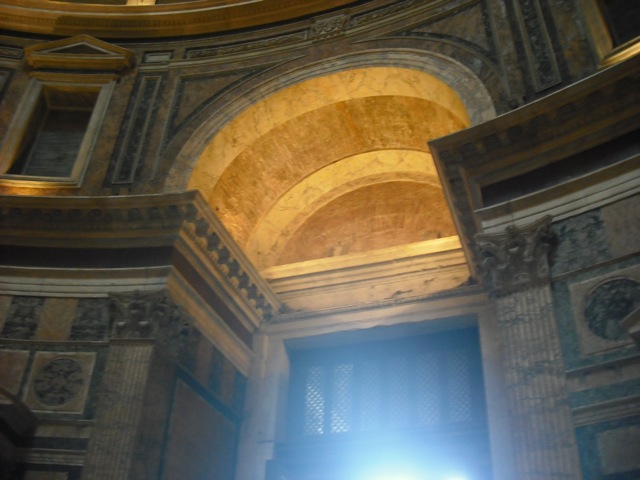Rome is a city of many layers (I just tried to type it in Italian, but forgot the word for layer and besides, most of you don’t read Italian). In the Centro Storico you only have to look around and most of the buildings show at least two layers. Oftentimes, it is a 19th century layer and a 16th or 15th century layer. And then there are some, like the hotel in which I reside, that have some amazing 4th century brickwork. It is, in short, an onion and in order for it to be any good, you got to peel it.
Ok, enough metaphor. Onto the Church of the Week: Santa Maria ad Martyres.
Most Roman churches, traditionally, are basilica in style as well as ecclesial designation. This of course means that most churches are long halls with side aisles and the altar is on the back wall etc. Santa Maria ad Martyres (SMaM) is not. The altar is still against the back wall, but the interior space is a circle. Of course, this is due not to an intense theology of community but instead becasue SMaM was originally built as a Monument/Temple to the Emperor of Rome. Generally in classical typography, the circle designated an honorific space. If ever there was someone to honor, it’s Gesucristo, thus it is in some ways an appropriate space for a Church.

Also because it was originally a Roman Temple, it has a large pedimented portico. It faces North toward the Piazza della Rotonda which is, by the way, named after the Church/Temple. The portico is eight Corinthian/Composite columns wide and four deep.

Inside the portico, the ceiling is exposed traditional heavy timber construction (which thrills my heart). As I said in my last installment on Sant’ Eustachio, most churches have exposed brick on the side elevations. SMaM is no different except in its case the bricks are Roman brick which is longer than ours and awesome. In fact coming upon it from the side, it just seems like an old brick wall. Kind of boring right? Well, although the exterior is old 2000 year old Roman masonry, stepping inside brings one into the Baroque.

Right across the rotunda from the entrance stands the high altar with its six tall candles. In fact, surprisingly, it is set up for the Extraordinary Form (I forget when they do it, because I usually go to SS. Trinitá for my Extraordinary needs.) In the center of the church is a roped off circle under the center of the dome (did I mention that there was a dome? There almost always is). This roped off section is for when it rains.

In the dome is a large round hole often referred to as an “oculus”. Whenever it rains, the water obviously comes through the hole and lands in the middle of the church. This could put a damper on both tourism and liturgy and so they rope off the center. I wanted to get a picture of the rain coming through, but it wasn’t raining hard enough when I was there.
Speaking of the dome, when it was designed, the coffers in the ceiling were not lined up perfectly and so they look sort of dynamic. It is made of Roman cement and is held in by large rings of stone on the outside.

Back to the interior. Between the Altar and the Door, there are side altars/shrines that periodically occur along the wall. These are entered through two column in antis (which, as you should remember, is two columns between flanking walls.) All around there is amazing marble which clads the walls and also beautiful mosaics on the ceiling of the apse.

Because it was originally Roman and later changed into a church, the walls were different at one point. In order to show this, whoever’s in charge of these monuments decided to reconstruct one of the sections of the Roman interior wall. Because of this, there is one bay of the interior that is different from the others. It is slightly weird.
If you haven’t guessed by now (and you should have even without looking at the pictures), Santa Maria ad Martyres is more commonly called “The Pantheon” I just didn’t want to give it away. And besides, as a church, that is its name. I will, however, forgive you if you refer to it as the Pantheon. Pantheon of course means “All the gods” or something like that and this Pantheon originally honored many other gods besides the Emperor. Of course the description of the Roman Pantheon would be a whole other article. Suffice it to say, the sun coming through the oculus had a lot to do with it and it was epic. I bet.
Anyway, tune in next time for another exciting installment of “Le Chiese delle Cittá”. Any requests?






11 thoughts on “Le Chiese delle Cittá: La Basilica di Santa Maria ad Martyres”
Can’t think of any requests off the top of my head! ^_^ I’ll have to keep my eyes open though in case I run across something that may be worth checking out.
What a fine book you are creating! What wonderful illustrations to accompany your words. I am happy to have a chance to hear your thoughts as you “experience” Rome. Your loving mother. TOX?
What a fine book you are creating! What wonderful illustrations to accompany your words. I am happy to have a chance to hear your thoughts as you “experience” Rome. Your loving mother. TOX?
I thought it bore repeating.
That’s one beautiful piece of architecture …
It was actually groundbreaking as it was one of the first (if not THE first) temple with a dome, the construction of which is a story in and of itself.
One of my architecture friends made the point last night that architecture is meant to be lived in, not just looked at, and I’d have to agree. Now everyone has to come to Rome. It’s an obligation. 🙂
Did you do Santa Maria in Vallicella ?
No, I did not. I will look into it. There are about ten thousand Santa Marias in Rome.
You should do SS. Cosma e Damiano in honor of their feast day on the 26th.
One might look for more images online and see the icon of Mary in this Church. It is one of the 7 pre-iconoclostic period images that survived the destruction at that time, so it is pre-700 AD. It is “protected” by a silver cover that hides most of it, but there is a replica in front of the altar which can be looked at closely in entirety. Mary is beautiful, and holds her Son. These pre-Byzantine images show a more personal vision of Mary, before a more stylized, prescribed tradition took hold.
You can’t see it very well because I couldn’t get close enough to the altar, but that golden-looking rectangle in the altar picture is the original.